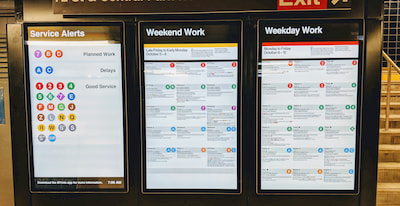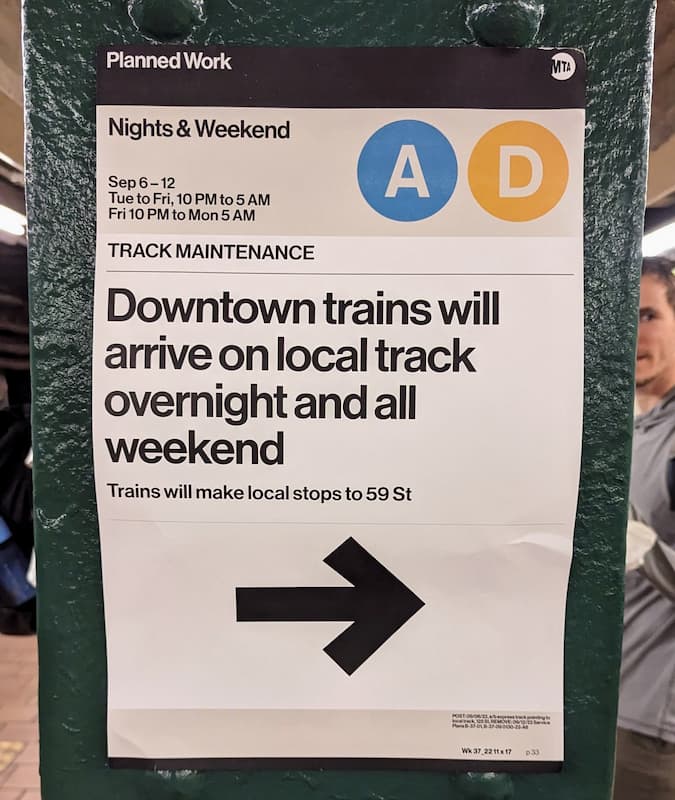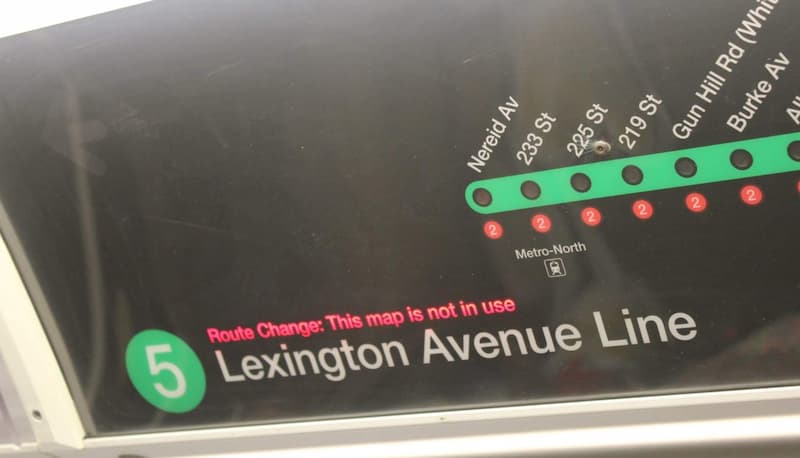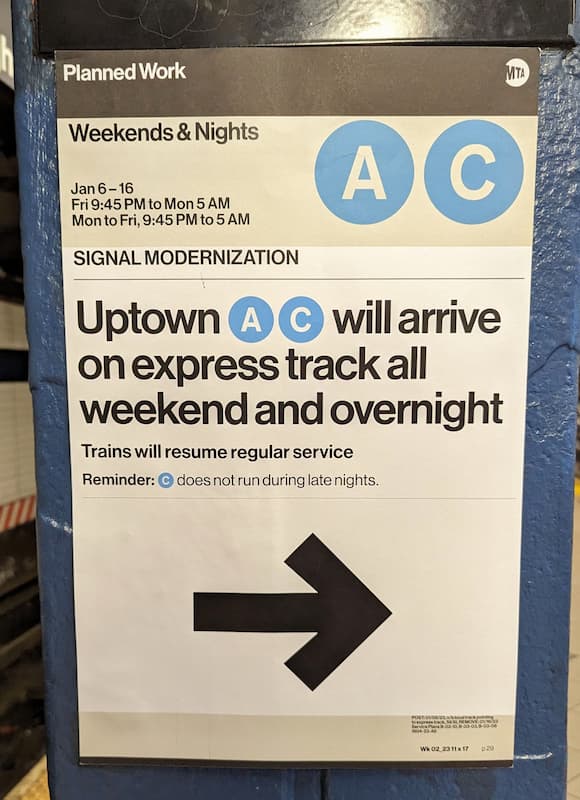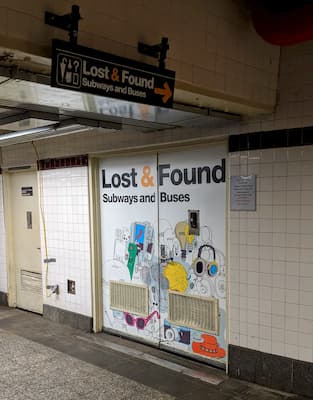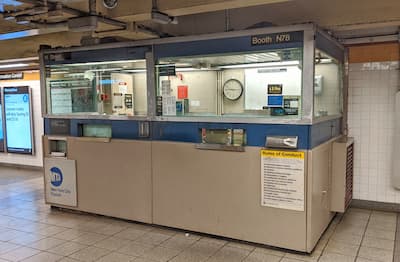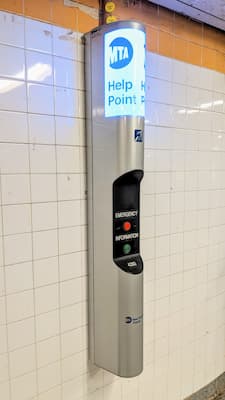Miscellaneous Info on the Subway
Service Changes
So far, so good. Confusing as the system already is, it's going to get even more confusing as you need to watch out for some caveats.
Evening service
In the evening (usually after 10pm) you'll see some subtle changes to the train routes. They arrive less frequently and run more slowly than usual. Express trains tend to become local, meaning that they stop at every station. This can be confusing because the train designation does not change. For instance, the
 train which during the day runs express between 59th St. and 125th St. suddenly starts stopping at each station in between, even though the official subway map does not show the "A" designation below any of these local stations. You can find exactly what happens to your service by looking at the Planned Service Changes on the MTA website. In the top-right corner of the official MTA map you can also find a box with descriptions of how each service changes at nights and on weekends. There also exists a dedicated late-night subway map.
train which during the day runs express between 59th St. and 125th St. suddenly starts stopping at each station in between, even though the official subway map does not show the "A" designation below any of these local stations. You can find exactly what happens to your service by looking at the Planned Service Changes on the MTA website. In the top-right corner of the official MTA map you can also find a box with descriptions of how each service changes at nights and on weekends. There also exists a dedicated late-night subway map.
Weekend service
A few train services have a different weekend schedule. For instance, the
 and
and
 trains never run on weekends. This is also described on the MTA map in the top right corner as well as on the planned service changes on the MTA website. However, in addition to these regular weekend schedules, there will also be a plethora of other planned service changes that are specific to the upcoming weekend. Because the subway system operates 24/7 for all 365 days of the year, maintenance of the tracks or construction has to be done while the system is in operation. To avoid disrupting rush-hour traffic, maintenance happens on weekends and they are guaranteed to cause various service disruptions every weekend. Note that Google Maps also incorporate weekend changes when searching for directions.
trains never run on weekends. This is also described on the MTA map in the top right corner as well as on the planned service changes on the MTA website. However, in addition to these regular weekend schedules, there will also be a plethora of other planned service changes that are specific to the upcoming weekend. Because the subway system operates 24/7 for all 365 days of the year, maintenance of the tracks or construction has to be done while the system is in operation. To avoid disrupting rush-hour traffic, maintenance happens on weekends and they are guaranteed to cause various service disruptions every weekend. Note that Google Maps also incorporate weekend changes when searching for directions.
As you enter stations and on subway platforms, you will find electronic displays or physical "Planned Service Changes" posters indicating the type of change:
The type of change is very specific to each service. Read those service alerts carefully to determine what your next options are and also pay attention to the dates as these posters are sometimes posted for an upcoming weekend instead of the current one. The most common type of changes are as follows:
Express turns local
Express trains turn local for a certain section. This isn't too bad because you can still use the same train to get to the same destination. You just have to endure stopping at every station that usually would have been skipped.
Local turns express
A local train that usually stops at every station is now an express train for a certain section. This usually means that in order to exit at your desired local station, you have to take this express train to the next express stop and then catch a local train in the opposite direction to end up at your desired destination.
A train replaces another service
Very often, a train is rerouted to a completely different train service altogether. For instance, the
 trains, which typically run on the Lexington Line on the east side of Manhattan, sometimes run on the 7th Ave. line on the west side of Manhattan. Somewhere downtown it forks from the usual 5 track but will eventually merge back to its original track somewhere midtown. What is confusing is that the train's designation will not change. It will continue to be identified as the
trains, which typically run on the Lexington Line on the east side of Manhattan, sometimes run on the 7th Ave. line on the west side of Manhattan. Somewhere downtown it forks from the usual 5 track but will eventually merge back to its original track somewhere midtown. What is confusing is that the train's designation will not change. It will continue to be identified as the
 train despite running on a different route.
train despite running on a different route.
To illustrate, you find yourself standing at Times Square and suddenly see the
 train approaching on the side of the platform where you otherwise would expect the
train approaching on the side of the platform where you otherwise would expect the
 train. The conductor's announcement should be something like, "This is a 5 train running on the 2 track." In those cases, just think of that train as a
train. The conductor's announcement should be something like, "This is a 5 train running on the 2 track." In those cases, just think of that train as a
 train. However, eventually the train will merge back to its original track and you might find some temporary sign posted in the station indicating when this will happen. Pay close attention to the conductor's announcement; they will let you know when the train returns to its original track.
train. However, eventually the train will merge back to its original track and you might find some temporary sign posted in the station indicating when this will happen. Pay close attention to the conductor's announcement; they will let you know when the train returns to its original track.
On some trains, the route map shows a warning light, indicating that it's incorrect:
Trains arrives on different side of platform
Occasionally you will also find a planned service flyer that indicates that a train arrives on an unexpected side of a platform like so:
In the above case, the  train which usually stops on the local track since it's a local train, is now arriving/stopping on the express track. However, since the flyer does not indicate otherwise, the
train which usually stops on the local track since it's a local train, is now arriving/stopping on the express track. However, since the flyer does not indicate otherwise, the  will continue running local as expected.
will continue running local as expected.
Train is complemented with a bus
The train is no longer running. You have to exit the subway station and take a shuttle bus that drives along the same route to each subway station. This takes longer since above-ground traffic tends be slower. These shuttle buses are always free and you do not have to swipe your MetroCard/OMNY payment method at all.
Train doesn't run altogether
This train is out of service. Find some other route using a combination of other trains to get to your final destination.
Miscellaneous information
Stay in the know:
- Follow the @NYCTSubway X (Twitter) handle for more up-to-date service changes.
- All stations have cell phone service and free Wi-Fi (SSID: TransitWirelessWifi). However, you won't have either service while riding the trains underground.
- You can chat with the MTA via WhatsApp or iMessage. Using your mobile phone, simply navigate to https://mta.info/whatsapp or https://new.mta.info/imessage respectively. An actual human operator will answer your questions in real-time.
- It's encouraged to wear masks on subways and buses, but it is no longer required. Free cloth masks are available station booths.
- Drinking alcohol or smoking and vaping is prohibited on the trains as well as anywhere in the stations.
- Don't board a train car that is unusually empty compared to others. There's probably a very good reason for this (i.e., there is some disgusting inside).
- The subway is more than 100 years old. It can be dirty and smelly down there. Don't be surprised to see rats crawling around the tracks and occasionally even on the platforms themselves.
- The vast majority of platforms and tunnels are not air-conditioned. The heat becomes unbearable in summer.
- The majority of subway stations do not have elevators. This means a lot of walking and climbing up stairs or using escalators. See the accessibility section below on how to navigate the trains with elevators.
- When you travel in a group, make sure everyone hops onto the train at the same time. Don't run ahead and catch a connecting train and risk leaving some members of your party behind when the door closes on them. This is especially important when you travel with children. Teach your children to enter or exit a train at the same as you do, and that if they are separated from you on a train, that they should exit at the next station and wait there for you to catch up.
- Some stations (such as the 145th St on the
 train) are so small that only a portion of the train can fit in it, so you must be in the first 5 cars of a train to be able to exit. The conductor will make such an announcement in the train several stops ahead giving you an opportunity to move your way to the front of the train at the previous stops.
train) are so small that only a portion of the train can fit in it, so you must be in the first 5 cars of a train to be able to exit. The conductor will make such an announcement in the train several stops ahead giving you an opportunity to move your way to the front of the train at the previous stops. - Unless you are on the new "open gangway" trains, do not walk between the cars of a train. It is illegal and dangerous.
- If you find yourself accidentally dropping something valuable onto the tracks while waiting for the train, never retrieve the item yourself. The third rail on the track is electrified (it's fatal if you were to touch it) and you can be run over by an oncoming train. Instead, notify a station agent in the station booths; they can notify someone else to retrieve the item for you properly.
Subway etiquette
There are some unspoken rules of etiquette to follow when you ride the subway. They may not be all that different from other transportation systems' ridership rules, but allow me to state them here:
- Don't stop suddenly in the middle of a stairway or hallway to talk or text on your mobile phone. You'll annoy those behind you.
- When you ride an escalator, stand to the right so others can walk past you on the left.
- When you approach a turnstile, have your payment device ready to swipe/tap.
- If you can't successfully swipe your MetroCard/OMNY device three times, be courteous and let some people behind you enter first before you try again.
- Before entering the train, let passengers exit the train first by standing to the left or right of the opening door.
- When you enter a train, be sure to walk all the way into the train. Do not stop at the entrance and block other people behind you from entering the car.
- Do not hold the doors open for others. You will delay the train (and the trains behind you) and annoy your fellow riders.
- Do not lean on the poles inside the train. People will want to hold on to them.
- Don't eat food that others can smell on the train (no matter how good it smells).
- Give up your seat for the elderly, small children, people with disabilities or pregnant women.
- On crowded trains, don't put your backpack or handbag on a seat that otherwise could be used by someone else.
- On crowded trains, don't wear backpacks on the back. Wear them in front or take them off altogether.
- Don't take up more of the seat than you need to.
- As you exit the subway station, don't stop at the top of the stairway and admire the scenery. There are people behind you who need to exit as well.
On homelessness, panhandling and scams
NYC has a large homeless population. While NYC does have homeless shelters, they do not have a good track record to provide safe harbor for the homeless there, which is why you often see homeless people prefer to seek shelter in subway stations on benches or on trains themselves. Note that there is nothing illegal for homeless people to use the subway provided that they paid for the ride, but the sight or smell can sometimes be uncomfortable. If you see a homeless person using up multiple seats on a train, it is probably best to leave them alone. You can call 311 to request assistance for someone you think needs help.
Panhandling is when someone asks people for money in a public space, and the subway system is not immune to that. In the subway stations, in addition to people begging for money, you often find people performing music to ask for donations and get some publicity. Some of them are actually officially sanctioned by the MTA -- they have to go through an application process, get vetted/selected and then perform with an official purple MTA banner behind them at popular stations like Times Square or Union Square. Unofficially, you also find many other people that have not gone through this process perform various acts on platforms to ask for money.
Panhandlers will also come on trains very often. These can be musicians, beggars asking for money, people selling candy/snacks or other people performing circus-like acts around the poles. The latter is referred to as "show time" among locals, because the group of young men usually blast loud music and yell "show time", and it is frowned upon because their acts take up space on the train, sometimes endanger passengers and the loud music can be a nuisance for commuters who have to deal with this every day. Some panhandlers are more aggressive than others. Some people are in real need for money to survive, but you will also hear the exact same sob story from some people over and over. In general, you don't have to give anyone any money.
There aren't many scams in the subway. Sometimes at turnstiles or at MetroCard Vending Machines, you will find people trying to sell you a subway swipe or trying to "help" tourists navigate the MetroCard vending machine and then ask for money afterwards. This is especially true at subway stations that connect to and from airports like the Sutphin Blvd-Archer Av-JFK Airport station on the


 near Jamaica Center. Don't give into these people. Selling subway swipes is illegal.
near Jamaica Center. Don't give into these people. Selling subway swipes is illegal.
While not technically on the subway, I do want to point out another scam that tourists fall for often. If you take the
 train to South Ferry to see the Statue of Liberty, you will be approached by officially looking people with vest as you exit the subway station trying to sell you tickets for the Statue of Liberty. Don't fall for them. These are scammers selling you overpriced tickets. Note that the Staten Island ferry to Staten Island (with great views of the Statue of Liberty) is completely free. If you want to buy tickets for boats to the actual Liberty Island, buy them online from Statue City Cruises (the only authorized vendor to sell tickets to the island) or at the actual booth at the Castle Clinton National Monument.
train to South Ferry to see the Statue of Liberty, you will be approached by officially looking people with vest as you exit the subway station trying to sell you tickets for the Statue of Liberty. Don't fall for them. These are scammers selling you overpriced tickets. Note that the Staten Island ferry to Staten Island (with great views of the Statue of Liberty) is completely free. If you want to buy tickets for boats to the actual Liberty Island, buy them online from Statue City Cruises (the only authorized vendor to sell tickets to the island) or at the actual booth at the Castle Clinton National Monument.
Frequently asked questions
- Is it safe to ride the subway?
While everyone will perceive safety and crime differently, the subway is generally safe to ride. Violence and crime on the subway peaked in the 1980s, but today New York City continues to be one of the largest safe cities in the world and less than 2% of the city's serious crimes happen on the subway. New Yorkers don't even worry about pickpocketing. Do not fall into the fear mongering often driven by the media or the increased presence of NYPD officers on stations. While it is easy to imagine something bad happening to you because you heard about one incident, the fact of the matter is that the NYC subway is a vast and large public space across many different parts of the city, and the chances of a particular crime happening to you is extremely low. That said, the city does suffer from a mental health crisis so you will encounter homeless people with mental health problems in the subway system, but they seldom pose an actual danger to riders. At night, if you find yourself feeling uncomfortable waiting for the train for too long, you can always wait near the subway station booth where the station agent can see you. - What mobile apps do you recommend?
There are tons of them out there -- I can't possibly list them all. However, do note that there is an official Trip Planner website and the MTA also has a MYmta mobile application available on the Google Play Store or the Apple App Store. I personally use this plain and simple subway map app. - Can I take luggage, bikes or strollers onto trains?
Yes you can, but you should consider several things. First, it might be strenuous to carry things up and down stairs since many subway stations do not have elevators. Second, avoid rush hour as the trains will be packed making it difficult to find space. See the accessibility section below on how to navigate the system with large items. - Can I take pets on the trains?
Yes, as long as they are fully-enclosed in a carrier and don't pose an annoyance to other commuters. Many commuters have a soft pet carrier where they place their cat or dog in. Service animals like guide dogs do not have to be in a carrier, but must be on a leash/harness at all times. - What should I do if I lost something on the subway/bus?
If you know that you lost an item at a specific subway station, your best bet is to find the station booth and ask the station agent there first. If you lost something on the subway or bus and a good samatarian has returned it to the MTA, your lost item might make its way back to the Lost & Found office. This might take a few days though, and it's best to start the process by filing a claim online first. That said, you can find the Lost & Found office at 34th St-Penn Station on the northern end near the stairs that go up the

 train:
train:
- Can I find restrooms in subway stations?
The vast majority of subway stations will not have public restrooms. Sometimes you will find restrooms in the newer or larger subway stations with a lot of transfers. However, these restrooms aren't always very clean, so you might be better off trying to find public restrooms outside of the subway system.
- Is there a discount for the subway?
If you are a senior citizen or a person with qualifying disability you can apply for what's called a Reduced-Fare MetroCard. You can apply online, by mail or in person at the New York City Transit’s Customer Service Center in Lower Manhattan. Upon approval, you are issued a personalized Reduced-Fare MetroCard (with your name and picture on it), which allows you to ride the subway and bus at a 50% discount. You can refill this card at a MetroCard Vending Machine. For more information, see the MTA website on reduced fares.
If you want to use the OMNY system, you still have to first apply and receive a Reduced-Fare MetroCard, and then go online at omny.info and chat with the Digital Assistant at the bottom-right corner and choose "Switch from Reduced-Fare MetroCard to OMNY" to link your Reduced-Fare ID with a specific OMNY payment method. Note that you have to you use the exact same payment method at turnstiles to get the discount. Your previous Reduced-Fare MetroCard will still be active and can still be used too. In the near future, the MTA will also introduce special Reduced-Fare OMNY cards as well.
Alternatively, you can also show your original US-based driver's license, passport (of any country), New York City Department of Aging ID card, Access-A-Ride card or Medicare card directly at any station booth, and the agent there can issue you a single disposable MetroCard at the price of $2.90 but that can be used for two rides (giving you essentially a 50% discount). Note that the $1-fee-per-card is waived here.
Full-time students in NYC's school system can also get discounted MetroCards through their schools.
NYC also has Fair Fares NYC program which provides a 50% discount to subway and buses for New Yorkers that meet certain low income requirements (120% of the federal poverty line). After applying online, you will receive a special Fair Fares NYC MetroCard. If you use that card to swipe, each individual swipe will only cost 50% of the normal fare. When purchasing a time window (e.g., 7-day or 30-day Unlimited Rides), you only have to pay 50% of the usual cost. An OMNY-capable Fair Fares system is in the process of being introduced this Summer 2024.
- Can I get a refund if I lost my MetroCard?
You cannot get any refunds for the monetary value portion of a MetroCard. However, if you have paid for an Unlimited Ride window using a credit card or debit/ATM card, you can get a prorated/partial refund for the unused/lost time by calling 511. See the MetroCard Balance Protection Program for more info. - What else can I use with the MetroCard or OMNY?
You can use your MetroCard or OMNY to pay for local bus rides. It's the same fare as the subway, so if you have an Unlimited Ride card, it's essentially free. If you have a Pay-Per-Ride card or paying using OMNY, it will cost you $2.90 per ride. However, there is a free transfer from the subway (and vice versa), so if you just used your Pay-Per-Ride card for a subway ride, you can transfer to a bus for free within two hours. If you have used the Pay-Per-Ride card for multiple people on the subway, you have to swipe the card only once on a bus. The display will tell you that there are multiple free transfers and the bus driver will let multiple people go through. Similarly, if you have used your Pay-Per-Ride card multiple times on the bus, you just need to swipe it a subway turnstile once and the turnstile will let multiple people go through.
You can also use your MetroCard to take the short (three-minute) tramway from Manhattan to Roosevelt Island, which gives you some nice views over Manhattan. Because it participates in the one-fare system, it's essentially free if you have an Unlimited Ride card. The same concept about transfers, described above, applies here as well if you use a Per-Per-Ride card. - Where else can I get help?
The easiest and fastest way to get help is to simply ask a local New Yorker. Don't be afraid of us. Contrary to popular belief, we are actually pretty friendly and helpful - we just like to get to the point quickly. So instead of long-windedly asking "Excuse me? Hi, I am a little lost here as I am not used to using the subway. I am trying to go to the Yankee stadium, and am not sure if this is the right train to take. Can you tell me if this if this is the place to stand for it?", just simply say "Excuse me? Is this an uptown train to Yankee stadium?".
Another very easy and fast way to get answers to your questions is using WhatsApp or iMessage to chat with the MTA. Using your mobile phone, simply navigate to https://mta.info/whatsapp or https://new.mta.info/imessage respectively to chat with a real MTA person. You can ask them anything from directions and elevator statuses to planned services changes or report any problems. You can also chat with them in many other languages.
Next, every subway station is guarantueed to have at least one station booth where you can often find the station agent (the MTA person assigned to this station): These booths are always "on the outside" of the system before you enter the turnstiles. If you encounter an empty booth, it's possible that you are at a large station where there are several of these station booths and you have to find the other station booths at other entrances. At large stations, you will also see MTA agents in yellow vests walking around the station to help commuters.
In addition, throughout the station you will also find these automated Help Point Centers where can speak to a service operator remotely: Lastly, you can also call 511 from any US-based phone. This will route you to New York State Travel Information Line for any question about subways, buses, railroads, or bridges and tunnels.
